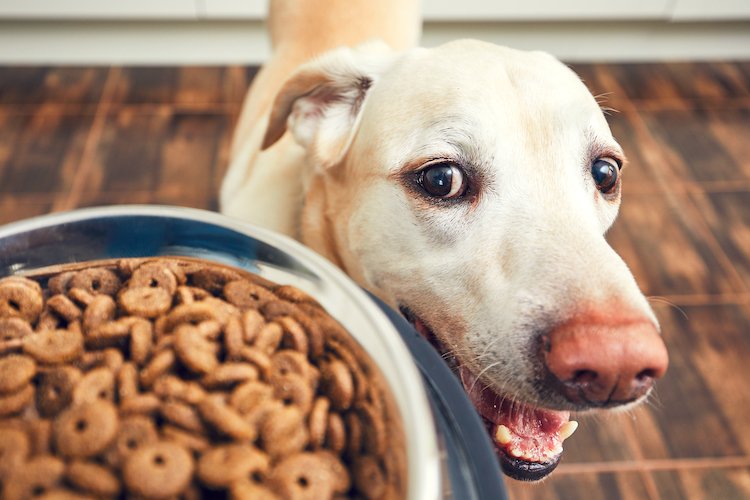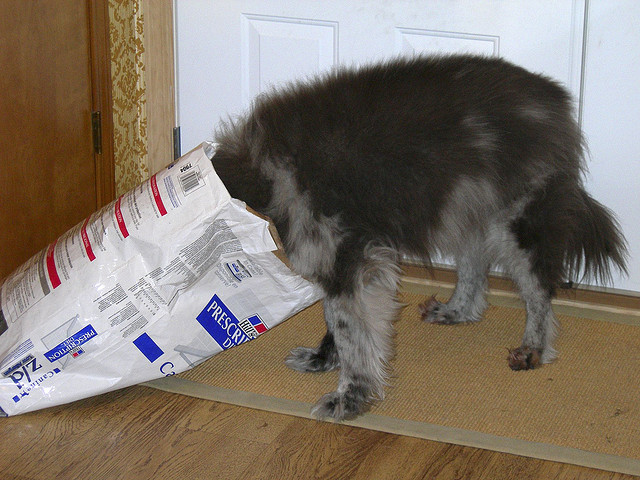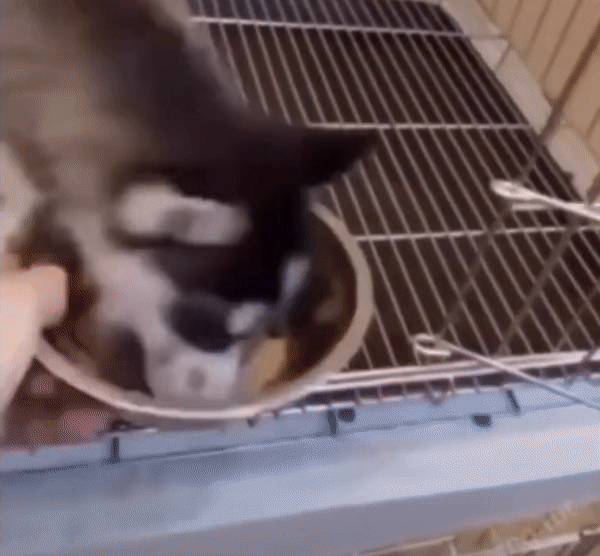
Help, my dog is food-obsessed!
I hear this all the time from pet parents: “Why does my dog eat so fast!?”
Many dogs gobble up food the moment it touches the floor. The good news? This is not a serious medical problem, although eating too fast could lead to some problems.
Voracious eating is usually a common behavioral issue, and it can irritate people who wish their dog would enjoy their meal a bit more rather than woof it down in 10 seconds.
Possible Reasons Why Your Dog Eats Too Fast
There is no definitive answer as to why some dogs eat as if they’re competing in Nathan’s Hot Dog Eating Contest. It truly boils down to a learned behavior early in life or a personality trait:
- Dogs who come from large litters may have had competition early in life for nourishment.
- Dogs in hoarding situations or dogs fed poorly or irregularly may also develop speed eating and food-guarding behavior.
- Some dogs exhibit fast eating only when they are around another dog.
- The majority of these little piggies, however, just dive into their food because food is incredibly gratifying to them. Most people can understand different attitudes about food since it’s the same in humans — some of us love to eat and eat too quickly, but other people have less interest in food or less of a food drive.

Problems Associated With a Dog Eating Too Quickly
Digestive Issues
Speed eaters can suffer from digestive problems, such as choking, gagging, burping, vomiting or regurgitating. Although most of these problems resolve on their own, some can be serious.
Gastric Dilatation-Volvulus (GDV)
Most dangerous is the possibility of bloat, or GDV — a life-threatening condition that requires immediate emergency intervention.
Although GDV is not solely associated with eating too fast, deep-chested breeds prone to GDV, such as the Great Dane, Standard Poodle, and many other large and giant breeds, should never be allowed to simply gobble up their food.
Food Bloat
While not as serious as GDV, food bloat usually occurs when a voracious eater gets into something like an entire bag of kibble or sometimes a tempting treat, such as 2 loaves of bread, and begins to bloat. Attention, all you budding bakers: Rising bread dough is particularly dangerous.
You cannot tell the difference between true GDV and food bloat, so both require an immediate trip to the veterinarian.
Any obvious and fairly acute distention of the abdomen, significant belching or attempts to vomit, or standing in a dull position and dry heaving is an emergency situation.
If you discover your dog has eaten a very large amount of food or bread dough, call the vet immediately.
A Couple More Problems Worth Mentioning
- Dogs who eat so fast that they barely chew their food will not get all the nutritional benefits of a good meal.
- It is particularly important that you choose a high-quality, highly digestible food if your dog tends to eat too quickly.

5 Tips to Slow Down a Dog Who’s Eating Too Fast
1. Special Food Bowls
An entire industry has developed around slow feeder bowls and food puzzles designed to slow down the crazy eater, both canine and feline alike. These products can work. There are also inserts that can be placed inside an existing food bowl.
- While most of these products work best for kibble, some are suited for canned or raw diet eaters.
- Other bowls are made for small or brachycephalic breeds.
2. Muffin Tins
A do-it-yourself suggestion is to simply divide up kibble into a muffin tin and use that as a dog bowl.
3. Food Puzzles
These products really make your dog work for food! I have been amazed at how quickly the food-driven dog can figure these out. Be aware of aggressive or food-guarding dogs with some of these products. If one morsel is left in a KONG, for example, your food-aggressive dog may be guarding that object from across the room and you may not be aware.
4. Hand Feeding
Labor-intensive but good for bonding, training and slowing down the speed eater, you can hand feed your dog over a few minutes.
5. Multiple Small Meals
Think about feeding your dog 4–5 times a day rather than just once or twice. Although your dog may still speed eat, you lessen the risk of bloat.
Was YOUR Pet Food Recalled?
Check Now: Blue Buffalo • Science Diet • Purina • Wellness • 4health • Canine Carry Outs • Friskies • Taste of the Wild • See 200+ more brands…

Speed Eaters Remain Speed Eaters
My own pup is a food gobbler, and I really dislike the behavior. She actually attacks a regular dog bowl and finishes her small-dog, 1/3-cup portion in about 8 seconds.
Yes, she has a slow feeder bowl, and I save her food puzzle for treats when we are leaving her alone for several hours. Still — and I realize I’m anthropomorphizing — I feel sad because she seems to take no true enjoyment in food. She’s obsessed, never satisfied. It’s like watching an obsessive-compulsive disorder.
And did I mention she’s overweight?
It’s really easy to overfeed these dogs because they always have that expectant look on their face. Anyone remember Little Shop of Horrors? Well, my dog is a little Audrey II. Her face constantly says, “Feed me.” She is only down a pound thanks to more exercise and a measuring cup.
Good luck with your speed eaters. There is one positive that comes to mind. If they are sick or getting sick, a speed eater might take 45 seconds to finish their food, and that means you’d better pay attention.
If they refuse a meal, please call your vet right away. The dog is probably truly ill.
Frequently Asked Questions (FAQ)
How Can I Stop My Dog From Eating Too Fast?
There are several tactics you could use to slow your dog down when they are eating fast. Specialized food bowls, puzzles, or a change in feeding schedule frequencies could help. If you’re really stuck, contacting a vet could further help you determine why your dog is eating so fast and what the best approach to help them is.
Is it Bad for Dogs to Eat Fast?
Yes. If your dog eats too fast and doesn’t chew, they run the risk of choking. Other digestive issues could arise as well, such as GDV or bloating.
Why Do Dogs Eat So Fast?
For some dogs who eat too fast, it could be because of a range of reasons. For example, it could be food anxiety, competition, just plain hunger, or there could possibly be an underlying medical reason. Assessing why your dog is eating so fast can help you determine how to best slow them down.
Can Dogs Throw Up From Eating Too Fast?
What happens when a dog eats too fast can vary. It is possible that scarfing down their food too quickly can cause it to come back up by vomiting. Other risks to be wary of when dogs eat too fast is the possibility of choking.
References
- “Gastric Dilatation-Volvulus.” American College of Veterinary Surgeons.
- Harper, Rob. “Approaches to Food Bloat.” Vet Times. Oct. 17, 2016.
- “Bread Ingestion in Pets on the Rise.” ASPCA Pro.
- “Hand Feed Your Dog Its Dinner – There are Many Benefits.” American Kennel Club. Oct. 29, 2015.
- London, Karen, PhD. “Tips to Stop Your Dog from Eating Too Fast.” The Bark. Sept. 2016.
- Llera, Ryan, DVM, and Robin Downing, DVM, CVPP, CCRP, DAAPM. “Feeding Times and Frequency for Your Dog.” VCA Hospitals.

This pet health content was written by a veterinarian, Dr. Debora Lichtenberg, VMD. It was last reviewed Oct. 16, 2020 and last updated on June 27, 2024.
If you have questions or concerns, call your vet, who is best equipped to ensure the health and well-being of your pet. This article is for informational purposes only and is not a substitute for professional medical advice, diagnosis or treatment. See additional information.


